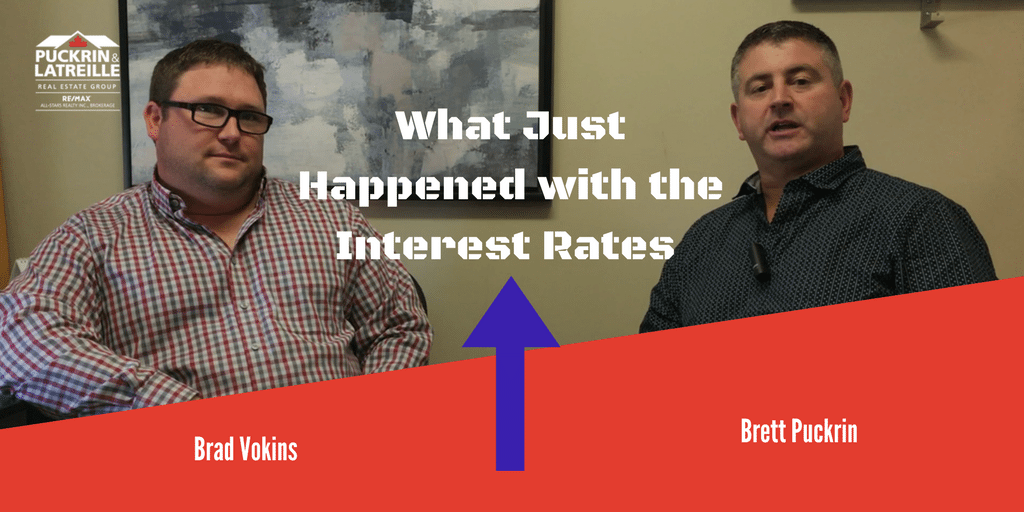It was bound to happen, and it did!
After close to a 10 year ride of having low interest rates this happened ……
“Canada’s mortgage-rate trendsetter, Royal Bank of Canada, hiked its posted five-year fixed mortgage rate Thursday (Jan 11, 2018) In days gone by, I never would have written about this. Posted rate changes were no big deal.
Today, they are “
To read the full The Globe and Mail (Jan 11, 2018) article we’ve included it at the end of this blog post.
[ by: ROBERT MCLISTER | SPECIAL TO THE GLOBE AND MAIL | PUBLISHED JANUARY 11, 2018 ]
Brett Puckrin and Brad Vokins weigh in on the recent RBC Royal Bank of Canada – Interest rate hike that happened yesterday (January 11, 2018).
So, What’s Really Going On?
The need to know and better understand how these interest rates will affect your bottom line is crucial. We ask a local Mortgage Agent to provide more context to the topic on hand.
Brett Puckrin, Sales Representative, Team Leader. Puckrin & Latreille Real Estate Group
Brett states “interest rate hikes will add to the new stress test but the author’s [from the Globe and Mail article ] approach to interest rate hikes is well founded”.Brett also continues to emphasize “Now more than ever, you need experienced advice and knowledge navigating the purchase of a new home. We have seen this type of market before and we can help your family make good decisions. Historically speaking, it is still an excellent time to move… we can help”
Brett Puckrin, AACI, P.App, PLE
RE/MAX All Stars Realty Inc., Brokerage
144 Queen St. Port Perry, ON L9L 1A6
Direct 905.985.7300
Brad Vokins – Mortgage Agent with Neighbourhood Dominion Lending Centres
This is a very excellent article and really explains what struggles people will or are having when shopping for a mortgage in 2018 to either purchase, refinance or switch to another Lender. We are seeing a lot more clients either having to stay where they are currently and try to save for a larger down payment or they are being steered in to the Alternative market or even taking on a Private Lender at higher rates and fees. Even some of the Alternative Lenders still have to follow the new stress test rules but they are not as strict on their qualifications, which will allow certain clients with 20% down or more to qualify. You may even see them change some of their policies to make it even easier to qualify.
For example you could see amortization be increase back up to 35 or even 40 years. It more important now than ever to have clients speak to a Mortgage Professional to see what their options are before trying to shop for a house, refinance or even try to switch to another Lender. Another item we are also seeing (in the industry) is people with weaker credit score that would normally qualify with the Big Banks are also being declined and are being forced into the Alternative Channel as well. A few late payments could mean the difference in paying 3.09% and 4.25% plus a few thousand in lender fees!
Source: Following was taken from The Globe and Mail (Jan 11, 2018)
Title: A major bank just hiked mortgage rates – and this time, it’s a big deal
ROBERT MCLISTER | SPECIAL TO THE GLOBE AND MAIL | PUBLISHED JANUARY 11, 2018
Canada’s mortgage-rate trendsetter, Royal Bank of Canada, hiked its posted five-year fixed mortgage rate Thursday (Jan 11, 2018) In days gone by, I never would have written about this. Posted rate changes were no big deal.
Today, they are
Government regulations now force most Canadians to prove they can afford much higher rates before getting approved for a mortgage. This “stress testing,” as it’s called, makes RBC’s seemingly insignificant rate change quite consequential indeed.
It’s been a long time coming
The Bank of Canada’s posted five-year fixed rate is used for most mortgage stress testing in this country, and it has been four years since it last exceeded 5 per cent.
RBC’s 15-basis-point increase to its posted five-year fixed rate could mark an epoch in Canada’s mortgage qualification rate. If a few more Big Six banks follow its lead (and I think they will), the qualification rate will jump from 4.99 per cent today to 5.14 per cent next week, making the stress test even harder.
In fact, mortgage borrowers haven’t had to qualify at rates that high since 2008 (back when government stress testing hadn’t even started).
Assuming other banks follow RBC, a 5.14-per-cent qualification rate would cut a borrower’s buying power (maximum mortgage amount) by roughly 1.4 per cent. For a household making $70,000 a year, that means a $4,000 to $5,000 smaller maximum mortgage. And the actual impact could be even more depending on the borrower’s qualifications, contract rate, equity and whether they have default insurance.
Now, $4,000 to $5,000 less “mortgageability” may not sound like much, but when you’re bidding against multiple buyers or desperate to consolidate high-interest debt, every $1,000 counts. That’s why up to 5 per cent to 10 per cent of uninsured bank borrowers (that is, those with 20-per-cent-plus equity who can’t pass the stress test) could migrate to credit unions this year. The higher the banks’ five-year fixed rates go, the more borrowers they’ll lose to credit unions.
The Bank of Canada’s on deck
If bond traders are right, the prime rate will rise 25 basis points after Jan. 17. (A basis point is 1/100th of a percentage point.) That’s because markets are pricing in a three-in-four chance the Bank of Canada hikes rates that day.
That, in part, has driven bond yields to four-year highs. And higher bond yields in turn drive higher fixed mortgage rates. But even if you knew higher rates were on the way, it wouldn’t help you pick a mortgage.
While traders expected rates to jump 50 to 75 basis points this year – and they very well might – rate expectations change on a dime. For all anyone knows, rates could dive next year or in 2020, thanks to Canada’s structurally low inflation, uncertainty over the North American free-trade agreement and housing headwinds, and hypersensitivity to interest rate hikes. That’s why your average mortgage rate over five years is far more important than your rate this year.
The best approach to hikes
Forget all the noise, forget your personal rate outlook and focus on risk management. This advice works because long-term rate moves are random and unpredictable.
The central question should be: If your mortgage rate jumps one or two percentage points by the time you renew, can you handle a 5-per-cent to 20-per-cent leap in your payments?
If yes, you can still find variable rates as low as prime minus 1.25% per cent (insured) and prime minus 0.86% per cent (uninsured). Anything better than prime minus 0.70% per cent offers solid risk-reward in this economy.
If you can’t comfortably handle a near-term jump in payments, you’re probably more suited to a five-year fixed. That’s not such a bad thing since the best five-year fixed rates are still below 3 per cent.
But five-year fixed rates below 3% per cent may not be around by year-end. So if you’re heavily risk averse or need a preapproval, lock ’em while you got ’em.
Robert McLister is a mortgage planner at intelliMortgage and founder of RateSpy.com. You can follow him on Twitter at @RateSpy


Stay Connected
With local real estate when you sign up for our newsletter. Join our mailing list here to get updates on the latest listings and expert insights.








